US Strategic Intelligence Strategy for Pakistan: Counterinsurgency, Diplomacy, and the Future
Christian M. Bills
Since the morning of September 11th, 2001, the United States has been at war, not with a singular country or group but with an ideology. Though the official declaration of war was not initiated until the following day, the smoldering ashes reminded us that America was not immune from foreign terrorist attacks. This forced the United States to take a long and solemn look in the mirror. Since that day Americas Strategic Intelligence Strategies have been overhauled, rethought, and torn-down several times over to ensure the safety of the country. However, as one could imagine this has been no simple task. Many locations where our military branches and intelligence agencies currently operate are nations are as complex and hostile as the terrorist organizations themselves. Afghanistan, Somalia, Iraq, and Libya are just a few that are infested with well-armed, well paid, and highly motivated terrorist groups. For all the threats and challenges that face Americas defense planners one of the greatest hurdles that must be overcome resides in Pakistan. Though Pakistan is an ally and is an active member in the United Nations, terrorist activity within its borders have forced planners to reevaluate the strategic goals and priorities for Pakistan. These challenges will be the foundation of my research as I search to answer three key questions: (1) What is the diplomatic relationship between the United States and Pakistan, (2) How have the Strategic Intelligence Plan evolved? and (3) Have the Strategic Goals been achieved? My findings will provide an understand of how Global War on Terrorism has affected our Intelligence Strategy goals for combating a non-state threat(s).
Diplomatic Relations: US & Pakistan
Following their independence from India and the United Kingdom in 1947, the United States and Pakistan established official diplomatic relations. This new alliance would be multi-faceted as the two countries planned on building lasting ties economically, politically, and militarily. It is reasonable to assume that at the time few would have considered the significance of this relationship over 70 years later. Pakistan serves as a key nation in the Global War on Terror as its location enables o US and other allied forces to conducts operations. Pakistan also possess strong and capable military resources, especially those of counter-terror/insurgency. According to the US Department of State “Pakistani forces have made significant sacrifices in recent years to reclaim parts of the country previously held by militant groups. In line with the South Asia strategy announced by the President in August 2017, the United States continues to encourage Pakistan to take decisive action to prevent all militant and terrorist groups from using its territory. Pending this action, the United States suspended security assistance to Pakistan in January 2018. The United States has generally been one of the largest sources of foreign direct investment in Pakistan and is its largest export market. Trade relations between the United States and Pakistan continue to grow and the U.S. government supports this relationship by funding reverse trade delegations, business conferences, technical assistance, and business outreach. (U.S. Relations with Pakistan, 2018) The statement by the Department of State expresses the three key aspects in the diplomatic relationship between the United States and Pakistan: counter-terrorism efforts, national and regional stability, and foreign economic investment. Yet despite enormous amounts of money and a herculean effort on behalf of government officials of both nations these are not always taken into consideration.
Supporting and pursing a counter-insurgency agenda is one of the most important factors that link the United States and Pakistan. Long before 9/11 Pakistan was deeply involved in a complicated game of politics and proxy-wars with terrorist groups within its own borders. This aspect has been analyzed by Seth Jones and Christine Fair, authors of the book Counterinsurgency in Pakistan, “After September 11, 2001, however, Pakistan abruptly changed its policy and assisted the United States in overthrowing the Taliban government, although some Taliban officials later acknowledged that the “ISI had even advised Mullah [Omar] to find a safe haven. Pakistan faced the stark option of abandoning the Taliban and supporting the United States or becoming the target of an American war.” (Jones and Fair, 2010, p. 14) We can see that the military ties between the United States and Pakistan is built on a bilateral agreement that both sides will purse and crush terrorist groups. Yet as Jones and Fair note Pakistan’s decision to subvert the goals of the United States and turn a blind eye to some most powerful terrorist groups in the region risks the possibility of losing America’s partnership.
Harboring or sponsoring terrorism confuses those who have studied Pakistan because of the, history of violence between the insurgency groups and the Pakistani government. John J. Le Beau, author of The Renaissance of Insurgency and Counter-Insurgency: Examining Twenty-First Century Insurgencies and Government Responses, asserts that the Pakistani government should have understood the risks and challenges that comes with allying the United States to eliminate terror groups. Le Beau argues that responses by terror groups are “Masses of civilians have routinely been the intended victims of Islamist attacks in Algeria, Thailand, Great Britain, Pakistan, Tunisia, Egypt, and elsewhere (most notably the United States). The Islamist elements of the Iraqi insurgency, specifically Al Qaeda in Iraq, have been widely regarded as the most egregious killers of civilians in that conflict, responsible for some of the worst high-casualty bombings in Baghdad and elsewhere.” (Le Beau, 2008, p. 10)
The aspect of increasing the stability of Pakistan has generally been regarded as the major priority of the United States-Pakistan counterinsurgency efforts. By seizing the opportunity offered by the America the expected result was a more stable nation and region; however, this has not been observed. Reasons for this are examined by authors Christine Fair, Keith Crane, Christopher Chivvis, Samir Puri, and Michael Spirtas in their book Pakistan. They state that “Since September 11, 2001, Pakistan has become increasingly unstable. Terrorist and insurgent groups operating out of Pakistan threaten the United States, the United States’ NATO allies, Pakistan’s neighbors, and Pakistan itself. The U.S. government will need to work assiduously to help stabilize Pakistan. It should have no illusions about the difficulties of the task. Financial aid alone will be inadequate: Massive amounts of foreign aid, most of which have gone to Pakistan’s military, have failed to stabilize the country.” (Fair, Crane, Chivvis, Puri, Spirtas, 2010, p. 1) Pakistani stability remains a priority observed by numerous military, political, intelligence, and media organizations. One example is found in a Washington Post Article Why Pakistan still needs U.S. assistance, by Jane Harman and Robert M. Hathaway. These writers see the long-term impact of the US-Pakistani Diplomacy given its trajectory from a developing nation to a rising global power. Harman and Hathaway state “Pakistan will soon have the fifth-largest population in the world. It already has the seventh-largest army and is close to overtaking Britain as the fifth-largest nuclear power. The country’s location, demographic heft, military might, nuclear weapons capability and links to Islamist terrorists ensure that it will remain central to U.S. interests even after NATO forces depart Afghanistan. In other words, as much as some might like it to be otherwise, writing Pakistan out of the U.S. foreign policy script is not an option. This is true even in the aftermath of last weekend’s NATO airstrikes that killed 24 Pakistani soldiers, triggering yet another crisis in the tortured U.S.-Pakistan relationship.” (Harman and Hathaway, 2011)
However, one of the most effective tools to foster the currently strained relationship is foreign investment. Since 2013 the United States alone has invested nearly four billion dollars in Pakistan, with the largest single year investment coming in 2015 at a total of $690,956,764 dollars. (Armstrong, 2018)
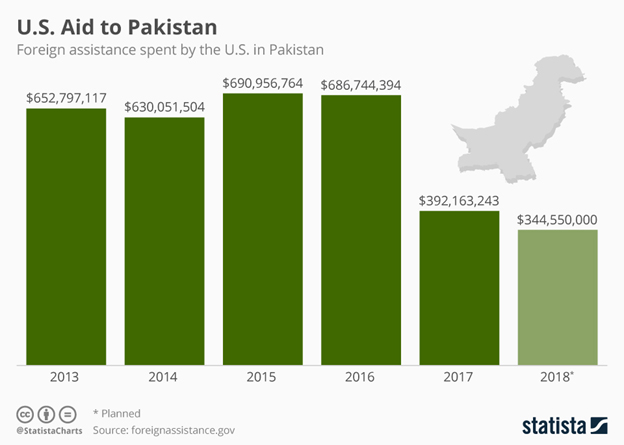
However, the development of Pakistan has fanned a political debate as to why America continues to fund a nation that, by many accounts, plays both sides of the fence. According to an editorial published by the New York Times, Is Pakistan Worth America’s Investment? the answer is a yes, at least for the time being. “Since 9/11, the United States has provided Pakistan with billions of dollars, mostly in military aid, to help fight extremists. There are many reasons to have doubts about the investment. Still, it is in America’s interest to maintain assistance — at a declining level — at least for the time being. But much depends on what the money will be used for. One condition for new aid should be that Pakistan do more for itself — by cutting back on spending for nuclear weapons and requiring its elites to pay taxes.” (2015) ‘Paying for partnership’ may be near an end as President Trump has made it very well known that he does not wish to continue this style of relationship. According to his Twitter Posts President Trump has made rather bold statements directed at Pakistan asserting that “the large sums spent recently by the U.S. on aid for the country do not match up to the alleged 'lies and deceit' received in return from Islamabad. In his second tweet of the year, Trump stated that due to the perceived nonreciprocal nature of the relationship between the two nations, there would be "No more!", signaling an end to the status quo and citing the lack of support in the fight against terrorists as the chief reason for the new approach. (Harman and Hathaway, 2011)
How Has the Strategic Intelligence Plan Evolved?
The Strategic Investment Plan between the United States and Pakistan has been anything, but a match made in heaven. Yet contrary to popular belief this is not how the relationship was always perceived. According to Malou Innocent, author of Pakistan and the Future of U.S. Policy, the partnership of the two nations was once strong and vibrant. She contends that “With only a few minor periods of discord, Washington and Islamabad were strategic partners throughout the Cold War. But Pakistan evolved from a marginal U.S. partner to a pivotal U.S. ally in December 1979, when the Soviet Union invaded Afghanistan. To Washington the invasion was a nightmare, coming just one month after the seizure of the American embassy in Tehran and less than five years after America’s retreat from Vietnam. For many policymakers, the Soviet invasion of Afghanistan solidified the impression that countries around the world neither respected nor feared the United States.” (Innocent, 2009, p. 4) United States was anxious to support and invest in Pakistan and strategists realized that Pakistan could be a crucial key in containing Soviet/Russian expansion; and as a stepping off point for future operations. Innocent asserts that “The Soviet–Afghan War was yet another chapter in an ongoing saga between Pakistan and Afghanistan. Islamabad viewed the Soviet– Afghan War as an opportunity to ensure that an Islamic government aligned with Pakistan, rather than a secular pro-Soviet government aligned with India, would come to power in Kabul after the Soviets withdrew.” (Innocent, 2009, p. 5) This bilateral agreement by the Pakistani’s and the United States was to ensure that friendly governments were in place to support their agenda solidifying Americas Strategic Intelligence Plans for the coming decades.
Events which have undercut the diplomatic and strategic intelligence plans include the United States continuing to increase interest in India, Pakistan turning a blind to terrorist groups, and conflicting views on Russia and China. Brookings contributor Stephen Cohen evaluates the deterioration over the last ten years in his article, The U.S.-Pakistan Strategic Relationship and Nuclear Safety/Security. According to Cohen “Pakistan used to be an important state because of its assets, but it is now important because of its problems. I am sure you are aware of Pakistan’s past reputation as a moderate Muslim state, but it has become virulently anti-American, it was the worst proliferator of advanced nuclear and missile technology and it continues to harbor—partially involuntarily—extremists and terrorists whose dedicated mission is to attack the United States.” (Cohen, 2008) This strong position underlines the current animosity that exists between law makers in Washington and those in Islamabad. However, the desire for the two nations to engage in healthy diplomatic relations is derived from two positions: (1) to cooperate on terrorism, (2) to limit the threat of Nuclear Weapons. Cohen supports this in his writing contending that “We [the United States] want Pakistan to cooperate on terrorism, we want it to normalize with India, we want to ensure that it will not proliferate nuclear technology.” (Cohen, 2008) However, this seems increasingly difficult as both nations are trending to do the opposite.
These rifts between the United States and Pakistan were highlighted in a 2015 Guardian story by Tim Craig of the Washington Post titled As the US moves closer to India, Pakistan looks to Russia. Craig argues that “As the US forges closer ties to India, neighbouring Pakistan is looking for some new friends. Officials hope they have found one in Russia – a budding partnership that could eventually shift historic alliances in south Asia. In recent months, Pakistani military and political leaders have reached out to Moscow, seeking to warm ties that have been frosty since the cold war.” (Craig, 2015) This potential shift in alliance by Pakistan to Russia threatens to put a dagger in decades of strategic planning. This would also be a massive blow for NATO by providing Russia with powerful ally in close to East Asia, Iran, and the Indian Ocean. Should this occur it would greatly reduce the power projected by the United States and its allies and would produce another hostile nation with Nuclear capabilities in a region of the world that is one rogue actor from initiating a global conflict.
This dilemma has not gone unnoticed by the United States Strategists as these issues were noted in the South Asia Strategy Plan of 2016. Contributor Thomas Lynch asserts that “South Asia will not be a glamour portfolio for the incoming U.S. administration’s security team in January 2017, but it will be one of top five importance. Critical U.S. national security interests are at stake that can be compromised gravely should the South Asia security portfolio be mis-appreciated or improperly managed. South Asia will require nontrivial defense expenditure and a focused, cohesive security framework advancing four major U.S. national security interests during the period from 2017 to 2020.” (Lynch, 2016 p. 1) Lynch argues that a the most pressing issue is trying to alleviate the pressure that is mounting between Pakistan and India. Neither is innocent of provoking issues however, Pakistan may have more skeletons in their closest. It has been noted by the United States and several other Western Powers that Pakistan has utilized terrorist groups to strike at India. Regardless, the United States has remained determined to hold onto its influence in Pakistan as policy makers and strategist understand its importance to winning the War on Terror. Lynch challenges this importance citing the fluctuations of success for joint operations.. He states that “The U.S. record of success in fighting terrorist actors in South Asia with Pakistan as an ally is not entirely positive. Yet the record of CT success without Pakistan’s participation during the period 1992–2001 is much worse. The delicate and dangerous situation calls for some form of continuing U.S. military engagement with Pakistani military headquarters in Rawalpindi, albeit at a reduced level, rather than a total cutoff of CT support or military-to-military interactions championed by some.” (Lynch, 2016, p. 10)
Have the Strategic Goals Been Achieved?
For all the hurdles and setbacks one thing is for certain, the governments of both nations continue to have a relationship. However, there has been serious debate amongst key political officials to determine if the strategic goals been met? Scholars and politicians tend to look at several key variables to answer this question, the most common three are the following: total investment (military and financial), health of the diplomatic relationship, and lastly Pakistan’s willingness to combat terrorism. Apart from total investment, these concepts are difficult to review numerically, therefore we are left with reviewing rhetoric and expert opinions on the current situation.
To begin it appears that the United States has begun efforts to move away from its security agreement with Pakistan. This has come in the wake of issues that have been building away from the spotlight as the United States government continues to support a pro-India campaign. According to a 2018 Reuters article by Arshad Mohammed and Johnathan Landay “The United States said on Thursday it was suspending at least $900 million in security assistance to Pakistan until it takes action against the Afghan Taliban and the Haqqani network militant groups.” (Mohammed and Landay, 2018) This action represented a clear sign that the United States is losing faith in the strategic intelligence goals for Pakistan. This is supported by a statement by a senior State Department official who claimed that “Our hope is that they will see this as a further indication of this administration’s immense frustration with the trajectory of our relationship and that they need to be serious about taking the steps we have asked in order to put it on more solid footing.” (Mohammed and Landay, 2018) This action seemed to be inevitable as President Trump has been quoted several times chastising the Pakistan government for “housing the very terrorists we fight.” (Henne, 2017) This statement by the President does indeed have some measure of truth as sources have noted Pakistan’s utilization and toleration of certain terrorist groups. According to Peter Henne of the Washington Post “Pakistan also failed to control its border with Afghanistan, which allowed militants to escape the U.S. military. This unstable situation continued after Musharraf stepped down in 2008 and a series of civilian leaders replaced him.” (Henne, 2017) This perceived lack of success on behalf of the Pakistanis does not appear to be correlated to the assistance provided by the United States. As the charts below indicate the fiscal investment to both domestic and military aid programs, as well as military assistance, via drone strikes.
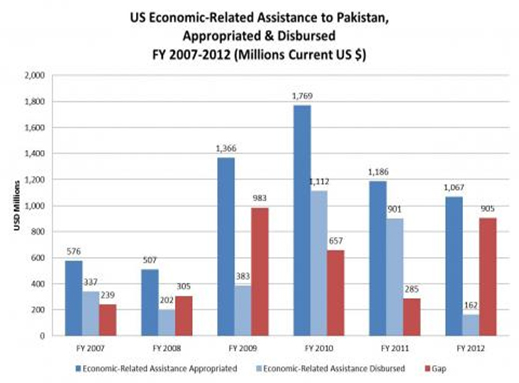
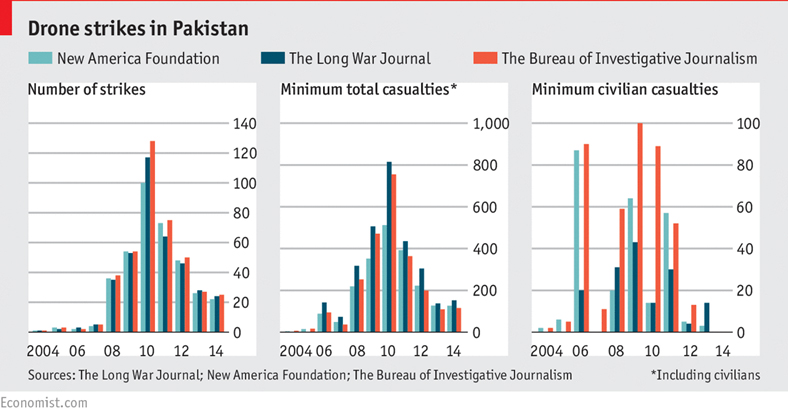
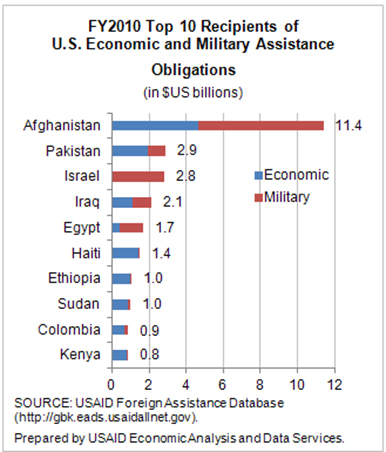
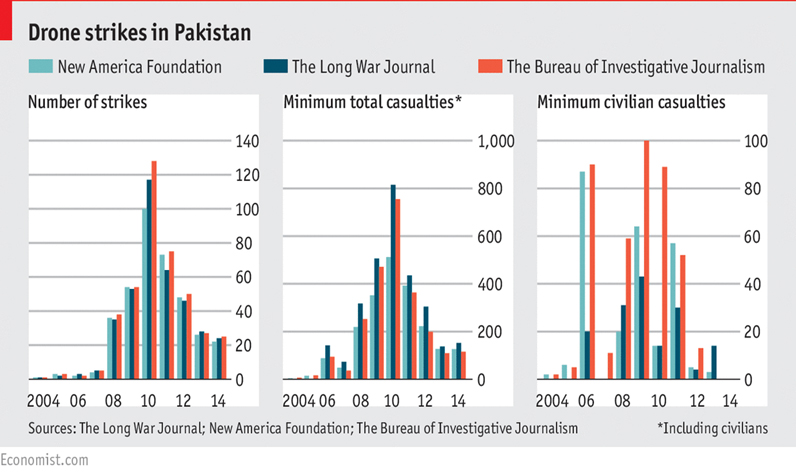
Image 5Aside from the monetary freeze for the Pakistani security fund there is also an icy edge to the rhetoric coming from both nation’s governments. From the American side it is evident that President Trump has viewed the partnership to be a one-sided effort however, Pakistani leadership the discontent is mutual. According to a Gallup poll conducted in 2012 “Pakistani disapproval of U.S. leadership soaring to an all-time high of 85% last year, hopes for achieving some normalcy between the nations appear somewhat grim. But Gallup data also show a sizable percentage of Pakistanis (43%) believe it is very important for Western and Muslim societies to get along -- suggesting this hope is not completely dead.” (Ray, 2012) This information shows that this feeling of dissatisfaction has not been one sided, even in the wake of the killing of Osama Bin-Laden the opinions of the Pakistani people remained relatively unfavorable to the United States as they argued that the incident “likely perceived it as further impingement on their sovereignty.” (Ray, 2012) In the United States not all are on the side of the President, according to CNN the assertions made by the Commander in Chief were ill-befitting and accusatory as the major news outlet stated that “Pakistan has received less aid than stated -- his words also isolated a critical ally in the war on terror. Without Pakistan by its side, the United States will struggle to find a clear endgame in Afghanistan and a viable partner in South Asia.” (Jawaid, 2018) The piece furthered its defense of the Pakistani efforts presenting statements on behalf of the Pakistan Minister for Defense Khurram Dastgir Khan who tweeted from his official account: "Pak as anti-terror ally has given free to US: land & air communication, military bases & intel cooperation that decimated Al Qaeda over last 16yrs, but they have given us nothing but invective & mistrust. They overlook cross-border safe havens of terrorists who murder Pakistanis." (Jawaid, 2018)
Though the saber rattling may be good for ratings the future of this alliance will be determined by how the two countries elect to pursue terrorist groups in and around Pakistan. The Pakistani government has allowed for the United States to perform operations and strikes close to and inside its borders providing several key victories, i.e. killing of Bin-Laden. Additionally, when provoked by insurgent groups the Pakistani military has been effective in responding, according to the Economic Times “At least 595 people, including Pakistani security officials, have been killed and 1,030 others injured in 262 terror attacks in the country during 2018, according to a report….[while] security forces killed a total of 120 militants in 2018 as compared to 524 in 2017.” (Economic Times, 2019) Not all share in this view of continued partnership as Alyssa Ayres argues in her CNN piece A lesson from the Kashmir bombing: America needs to get tougher on Pakistan. She contends that “That this terrorist group, nominally banned, remains at large in Pakistan illustrates the limitations on US foreign policy tools. It also means the US should put even more pressure on Pakistan, after President Trump began his time in office taking a harder line. A year ago, the Trump administration suspended security assistance to Pakistan as punishment for the country's hosting of terrorist groups that attack Afghanistan. But Pakistan still allows internationally designated terrorists to operate openly and plot attacks on its neighbors, according to the US, India and independent experts. This spells bad news not only for India-Pakistan relations, already at a low and about to sink further, but also for security in South Asia more generally—especially with a negotiation process underway on the US presence in Afghanistan.” (Ayres, 2019) This piece by Ayres would encapsulate most of the opinions in Washington D.C. as the officials grow tired of situation in Pakistan.
Conclusion
Given all the evidence and analysis provided by numerous scholars, journalists, and politicians I would contend that he Strategic goals of the United States in Pakistan are dangerously close to failing. As was discussed in the research concerning the diplomatic relationship of the United States and Pakistan have been rocky at best for several decades. To compound this both leaders of the countries are seemingly disinterested in mending the relationship at hand. Other issues such as, how the strategic plans evolved over time shows a lack of communication and absence of realistic goals. This includes the future of the Pakistani nuclear program, its relationships with Russia and India, and lastly the history of ignoring terrorist activity. The final wobbly brick in this review of the strategic intelligence plan is being able to measure the level/probability of success. The lack of accountability on behalf of the Pakistani’s to actively combat terrorist groups, the fragile relationship with Pakistan, and the diplomatic backpedaling all suggest that our goals have yet to be met and will more than likely not be met unless something monumental occurs. Considering these points, I have concluded that the goals of the Strategic Intelligence Plan have not been met. Until these are addressed, I believe that the goals will remain beyond our grasp and the divide between the United States and Pakistan will continue to grow, greatly weakening the effort to thwart international terrorism both at home and abroad.
The opinions expressed in this article are those of the author and do not reflect the official views of the Government of the United States, the Department of Defense, or the United States Air Force.
References
Armstrong, Martin. U.S. Aid to Pakistan. (2018) Foreign Assistance. Retrieved March 1, 2019, from https://www.statista.com/chart/12384/us-aid-to-pakistan/
Ayres, Alyssa, (2019, February 5) A lesson from the Kashmir bombing: America needs to get tougher on Pakistan. CNN. https://www.cnn.com/2019/02/15/opinions/kashmir-bombing-america-needs-to-get-tougher-on-pakistan-ayres/index.html
BUREAU OF SOUTH AND CENTRAL ASIAN AFFAIRS (2018). U.S Relations with Pakistan (Department of State Publication: Fact Sheet). Washington, DC:. Retrieved from https://www.state.gov/r/pa/ei/bgn/3453.htm
Cohen, Stephen P., (2008, June 12) The U.S.-Pakistan Strategic Relationship and Nuclear Safety/Security. Brookings.edu/testimonies. https://www.brookings.edu/testimonies/the-u-s-pakistan-strategic-relationship-and-nuclear-safetysecurity/
Craig, Tim, (2015, February 3) As the US moves closer to India, Pakistan looks to Russia. The Guardian. https://www.theguardian.com/world/2015/feb/03/pakistan-russia-us-obama-india
Editorial Board of the New York Times. (2015, January 9) Is Pakistan Worth America’s Investment. New York Times. https://www.nytimes.com/2015/01/10/opinion/is-pakistan-worth-americas-investment.html
Harman, Jane, & Robert M. Hathaway. (2011, December 1) Why Pakistan still needs U.S. assistance. The Washington Post, https://www.washingtonpost.com/opinions/why-pakistan-still-needs-us-assistance/2011/11/30/gIQAuJ2OIO_story.html?utm_term=.bfa7a9c922c9
Henne, Peter S., (2017, August 27) Trump says Pakistan ‘harbors terrorists.’ The real story isn’t so simple. The Washington Post. https://www.washingtonpost.com/news/monkey-cage/wp/2017/08/28/trump-says-pakistan-harbors-terrorists-the-real-story-isnt-so-simple/?utm_term=.8f37380e9101
Innocent, Malou. (2009). Pakistan and the Future of U.S. Policy. Political Analysis, 636, 1-28. https://www.jstor.org/action/doBasicSearch?Query=Pakistan+and+the+future+of+US+policy&filter=
Jawaid, Arsla, (2018, January 4) Trump’s Unfair Attack on Pakistan. CNN. https://www.cnn.com/2018/01/04/opinions/trump-pakistan-danger-opinion-jawaid/index.html
John J. Le Beau. (2008). The Renaissance of Insurgency and Counter-Insurgency: Examining Twenty-First Century Insurgencies and Government Responses. Connections, 7(1), 154-166. https://www.jstor.org/stable/10.2307/26323325
Lynch, Thomas F., (2016) Chapter 13: Counter-Insurgency. South Asia (pp. 267-295). U.S. Department of State. https://www.state.gov/sout_asia/strategy/pakistan
Mohammed, Arshad & Jonathan Landay, (2018, January 4) U.S. suspends at least $900 million in security aid to Pakistan. Reuters. https://www.reuters.com/article/us-usa-pakistan-aid/u-s-suspends-at-least-900-million-in-security-aid-to-pakistan-idUSKBN1ET2DX
Rand Corporation. (2010). Counterinsurgency in Pakistan. Santa Monica, California: Seth G. Jones and C. Christine Fair. Retrieved from https://www.jstor.org/stable/10.7249/mg982rc.10
Rand Corporation. (2010) Pakistan: Can the United States Secure an Insecure State? C. Christine Fair, Keith Crane, Christopher S. Chivvis, Samir Puri, and Michael Spirtas. https://www.jstor.org/stable/10.7249/mg910af.13
Ray, Julie. Opinion Briefing: New Normal Unclear for U.S., Pakistan. Gallup. Retrieved March 2, 2019, from https://news.gallup.com/poll/152192/Opinion-Briefing-New-Normal-Unclear-Pakistan.aspx
262 Terror attacks killed 595 people in Pakistan. (2019, January 7). The Economic Times, https://economictimes.indiatimes.com/news/defence/262-terror-attacks-killed-595-people-in-pakistan-in-2018-report/articleshow/67417709.cms
About the Author(s)
Comments
We are committed to…
We are committed to providing our clients with exceptional solutions while offering web design and development services, graphic design services, organic SEO services, social media services, digital marketing services, server management services and Graphic Design Company in USA.
